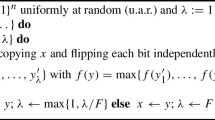Abstract
The performance of Evolution Strategies (ESs) depends on a suitable choice of internal strategy control parameters. Apart from a fixed setting, ESs facilitate an adjustment of such parameters within a self-adaptation process. For step-size control in particular, various adaptation concepts were evolved early in the development of ESs. These algorithms mostly work very efficiently as long as the relative sensitivities of the parameters to be optimized are known. If this scaling is not known, the strategy has to adapt individual step-sizes for the parameters. In general, the number of necessary step-sizes (variances) equals the dimension of the problem. In this case, step-size adaptation proves to be difficult.
The algorithm presented in this paper is a development based on the derandomized scheme of imitative step-size control. The new adaptation concept uses information accumulated from the preceding generations with an exponential fading of old information instead of using information from the current generation only. Compared to the conventional adaptation scheme, this enables a less locally determined step-size control and allows a much faster adaptation of individual step-sizes without increasing disturbing random effects and without additional evaluations of the fitness function. The adaptation of the general step-size can be improved as well.
Preview
Unable to display preview. Download preview PDF.
Similar content being viewed by others
References
Hoffmeister, F. & Bäck, T. (1991). Genetic algorithms and evolution strategies: Similarities and differences. In (Schwefel & Männer 1991), pages 455–470.
Ostermeier, A., Gawelczyk, A., Hansen, N. (1994). A Derandomized Approach to Self Adaptation of Evolution Strategies. In Evolutionary Computation (to be published).
Rechenberg, I. (1973). Evolutionsstrategie: Optimierung technischer Systeme nach Prinzipien der biologischen Evolution. Stuttgart: Frommann-Holzboog.
Rechenberg, I. (1978). Evolutionsstrategien. In B. Schneider and U. Ranft (Eds.), Simulationsmethoden in der Medizin und Biologie, Berlin: Springer.
Rechenberg, I. (1994). Evolutionsstrategie '94. Stuttgart: Frommann-Holzboog (in print).
Schwefel, H.-P. (1977). Numerische Optimierung von Computer-Modellen mittels der Evolutionsstrategie. Volume 26 of Interdisciplinary systems research. Basel: Birkhäuser.
Schwefel, H.-P. (1981). Numerical Optimization of Computer Models. Chichester: Wiley.
Schwefel, H.-P. (1987). Collective phenomena in evolutionary systems. In Preprints of the 31st Annual Meeting of the International Society for General System Research, Budapest, 2: 1025–32.
Schwefel, H.-P. & Männer, R. (Eds.) (1991). Parallel Problem Solving from Nature, volume 496 of Lecture Notes in Computer Science. Berlin: Springer.
Voigt, H.-M., Born, J. & Treptow, J. (1991). The Evolution Machine. Manual. iir, Informatik, Informationen, Reporte.
Author information
Authors and Affiliations
Editor information
Rights and permissions
Copyright information
© 1994 Springer-Verlag Berlin Heidelberg
About this paper
Cite this paper
Ostermeier, A., Gawelczyk, A., Hansen, N. (1994). Step-size adaptation based on non-local use of selection information. In: Davidor, Y., Schwefel, HP., Männer, R. (eds) Parallel Problem Solving from Nature — PPSN III. PPSN 1994. Lecture Notes in Computer Science, vol 866. Springer, Berlin, Heidelberg. https://doi.org/10.1007/3-540-58484-6_263
Download citation
DOI: https://doi.org/10.1007/3-540-58484-6_263
Published:
Publisher Name: Springer, Berlin, Heidelberg
Print ISBN: 978-3-540-58484-1
Online ISBN: 978-3-540-49001-2
eBook Packages: Springer Book Archive




